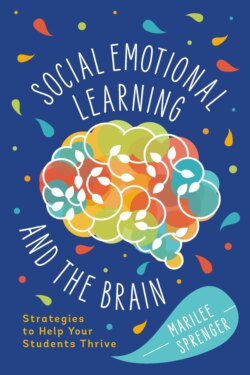Читать книгу Social-Emotional Learning and the Brain - Marilee Sprenger B. - Страница 27
Greet Students at the Door
ОглавлениеA recent study suggests that greeting and welcoming students each morning increased achievement by 20 percent and lowered disruptive behaviors by 9 percent (Cook, Fiat, & Larson, 2018). The study included the following suggestions for teachers:
Say the student's name.
Make eye contact.
Use a friendly nonverbal greeting, such as a handshake, high five, or thumbs-up.
Give a few words of encouragement.
Ask students how their day is going.
My granddaughter once said to me, "My favorite part of coming to your house is knowing you'll be waiting at the door to see us! How do you know exactly when we will be there?" In response, I said, "It's simple, Maeve. When you look forward to seeing someone—you know, that 'I can't wait' feeling—you make that foremost in your mind. I ask your parents to text me when you are close, and I wait at the door. I always greet my students at the door to let them know how excited I am to see them and that I care about them!"
And so I did—and I do. The truth? As a teacher, I couldn't wait to see most students, but I had to be there for all of them; so I was always at the door to greet them. In fact, some classes waited outside the door until I showed up to welcome them in. I did this every day, for every class. And it made a difference. For those who did not appear to be receptive, I was still there, smiling, saying, "Good morning" or "Hello" or just "Happy to see you!"
They were 5th graders. It was a tough school, a tough crowd. It was hard for me to believe that 11-year-olds could be scary—that is, until I stood before them. I was acting assistant principal when one of our 5th grade teachers divorced her husband, broke her contract, and moved away with her two kids. She had been struggling for months with her marriage and had used up all her sick days for mental health reasons and to see her attorney.
The students at this school came from backgrounds of generational poverty or broken homes or had a parent in prison. They had trusted this teacher, and slowly, over time, she had let them down, just as their parents had let them down. When she left, the students trusted no one and found yet again that they were alone in the world. They were angry. And we know that anger is the bodyguard of fear. They were afraid to trust. After several subs came and went, we decided that I would take over this class until the end of the year.
We were one month into the second semester. I stood at the door that first morning to shake their hands and say hello. Only 2 of the 24 students reciprocated with a handshake. Most looked at me blankly. One of the students, Jamail, said, "What are you doing here? Who's in trouble?"
After they all entered and were seated, I turned off the music I had playing. I explained that I was going to be their teacher and hoped that we could all work together to make the class and learning successful for everyone.
Every day I stood at the door to greet them and shake their hands. Every day the response was the same. I thought about giving up on the morning greeting. The students had felt abandoned; I was feeling rejected.
In time, the students responded somewhat to the brain-compatible learning strategies that I used. They began to feel more successful as they interacted with one another, worked in cooperative groups, and became more aware of others' feelings as well as their own. It was the social-emotional learning connection that made a difference.
After 17 mornings of my standing by the door to greet them, the "leader of the pack" reached out to shake my hand. Quinn, the best-dressed and cockiest student of all, shook my hand and echoed back my greeting when he said, "Good morning. I'm glad you're here today." Was he just mocking me? It didn't matter. At least it was a response!
After that, the other students slowly followed suit. What made the difference? It wasn't my persistence. It wasn't my smile. They didn't feel sorry for me because no one would respond. It was the fact that I was there—every day. I showed up. I couldn't dare be absent. They had to see that they could again count on someone.
No one has to explain to you how to greet a friend, but, after making eye contact and saying the person's name, you can make a greeting more powerful by doing one of the following:
Ask a question: What's your favorite ____? (You can ask about color, season, food, kind of pizza, animal, and so on.)
Make a request: I could use your help with a bulletin board. (Alternatives might include using an app, solving a problem, or taking attendance.)
Use nonverbal signals: These may include smiles, high fives, handshakes, hugs. (It took a long time before some students would let me touch them—particularly those who had been mistreated or abused in some way. Be patient and know that some students may never let you touch them.)
